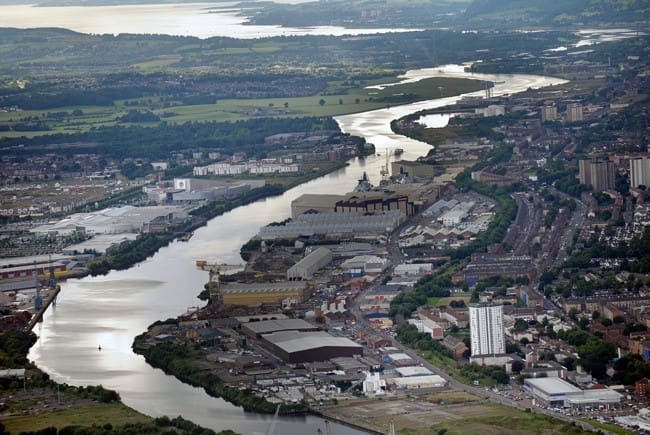Adaptation pathways is a decision-making tool employed to adapt to climate change and the inherent uncertainties of future risk. This research sets out to explore the evidence base to help design and apply adaptation (investment) pathways to the tidal reach of the Clyde drawing on international practice and UK guidance.

This research is a first for Scotland providing:
- information to help frame actions and decisions at a local, regional and national level around future flood resilience and long-term adaptation on the Clyde;
- practical insights into the application of adaptation pathways practice to the Clyde; and
- a starting point for the co-design and development of a route map and future actions.
Over the last 200 years the Clyde has experienced significant adaptation and transformation. Building on this history of adaptation, stakeholders have expressed a desire to re-imagine the current relationship between the river, people and place; to create a vibrant connected river corridor and waterfront, and make the river “an asset to be proud of”.
The approach to adaptation for the Clyde will need to be transformation-orientated, with place making and resilience at the heart of investment decision making and future pathway design.
Recommendations
Recommended first steps for adaptation on the Clyde include to:
- agree a framework for the application of adaptation pathways for the Clyde that fosters systems-thinking and a process for place-based decision making;
- agree what “a resilient Clyde” means, to inform design principles for investment and pathway development, and shape indicators for monitoring and evaluation;
- establish a ‘resilience zone’, a geographic boundary for decision-making;
- build an action plan (Mission Map) for the first five years of investment; and
- scope and develop a knowledge portal to support innovation, collaboration and long-term monitoring and evaluation.
“This independent report is yet another reminder of the climate change issues that we face, in this case along the Clyde. My challenge is this – that the partners in Clyde Mission, including this Government, the City Region and Local Authorities work together and with other key partners to fully consider this report and develop an approach which is innovative, assists and promotes investment and builds the resilience of our communities and businesses.”
Màiri McAllan, Minister for Environment and Land Reform
“The successful cities of the future will be those which put climate change adaptation at the heart of decision making. This comprehensive report, focussing on the tidal Clyde, is an important first step in making climate change adaptation a business-as-usual consideration for communities, local government, agencies, and the private sector. I look forward to working with colleagues in Clyde Mission to translate the report’s recommendations into action.”
David Harley, Head of Water and Planning (SEPA), Climate Change Adaptation Lead (Clyde Mission)
Scottish Government guidance strongly encourages managed adaptive flood risk management. However, none of the schemes in the 2016-2021 delivery cycle incorporate adaptive plans or reference multiple climate change scenarios.
This project looks at case studies developing adaptive flood risk management plans to inform guidance. It particularly looks at how to address the five critical barriers identified in our 2019 report Taking a managed adaptive approach to flood risk management planning in Scotland.
The aim is for future guidance to help local authorities embed adaptive approaches and, in doing so, support the resilience of people and places to a changing and uncertain climate, and create greater long-term value and societal benefits.
The recommendations are based on three case studies; Outer Hebrides coastal adaptation, Moray fluvial adaptation, and The Clyde tidal adaptation.
Key findings and recommendations
- Managed adaptive approaches to flood risk management in Scotland are far from mainstream, and emerging practice is not yet keeping pace with policy ambitions
- The three case studies explored in this research illustrate that the concept of a managed adaptive approach, although not widely in use, is flexible enough to support a range of local circumstances and applications, including: asset-orientated, stakeholder-orientated and transformation-orientated adaptation ambitions and investments.
- The case studies also demonstrate the value of “learning by doing” which in itself is a core aspect of taking a managed adaptive approach to flood risk management planning, and important to scaling up future activity and promoting successes.
- To this effect this research highlights the importance of the ‘getting started and framing’ phase and involvement of stakeholders. To set adaptation investments up for success, it is therefore recommended (regardless of the approach adopted) that step 1 of the process is positioned as a readiness assessment and includes five core activities:
- Define ambitions, success and value – ambitions should be co-designed with stakeholders and include a local definition of resilience (now and in the future).
- Plan the adaptation process – co-design of the process and approach with stakeholders.
- Funding and finance – initial assessment of the potential funding and financing opportunities reflecting the adaptation ambitions and wider local, regional and national strategies, policies and plans.
- Monitoring and evaluation – drawing on the statement of ambitions and definition of resilience an initial assessment of indicator needs and data availability should be completed.
- Capacity building and learning – an initial assessment of the capacity and capabilities of the project partners should be undertaken to determine resource, expertise and skills needs. This assessment should consider the importance of fulfilling four key design roles: systems thinker, leader and story-teller, designer and maker, and connector and convenor.